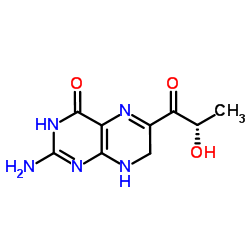L-Sepiapterin

L-Sepiapterin structure
|
Common Name | L-Sepiapterin | ||
|---|---|---|---|---|
| CAS Number | 17094-01-8 | Molecular Weight | 237.215 | |
| Density | 1.9±0.1 g/cm3 | Boiling Point | 448.1ºC at 760 mmHg | |
| Molecular Formula | C9H11N5O3 | Melting Point | > 275 °C (lit.) | |
| MSDS | Chinese USA | Flash Point | 224.8ºC | |
|
Bone Morphogenic Protein 4 Mediates NOX1-Dependent eNOS Uncoupling, Endothelial Dysfunction, and COX2 Induction in Type 2 Diabetes Mellitus.
Mol. Endocrinol. 29 , 1123-33, (2015) We have recently shown that angiotensin II-mediated uncoupling of endothelial nitric oxide synthase (eNOS) contributes to endothelial dysfunction in streptozotocin-induced type 1 diabetes mellitus. However, it has remained unclear whether and how eNOS uncoupl... |
|
|
Sulfa drugs inhibit sepiapterin reduction and chemical redox cycling by sepiapterin reductase.
J. Pharmacol. Exp. Ther. 352(3) , 529-40, (2015) Sepiapterin reductase (SPR) catalyzes the reduction of sepiapterin to dihydrobiopterin (BH2), the precursor for tetrahydrobiopterin (BH4), a cofactor critical for nitric oxide biosynthesis and alkylglycerol and aromatic amino acid metabolism. SPR also mediate... |
|
|
Stromal cell-derived factor 2 is critical for Hsp90-dependent eNOS activation.
Sci. Signal. 8 , ra81, (2015) Endothelial nitric oxide synthase (eNOS) catalyzes the conversion of l-arginine and molecular oxygen into l-citrulline and nitric oxide (NO), a gaseous second messenger that influences cardiovascular physiology and disease. Several mechanisms regulate eNOS ac... |
|
|
Statin-induced inhibition of breast cancer proliferation and invasion involves attenuation of iron transport: intermediacy of nitric oxide and antioxidant defence mechanisms.
FEBS J. 281(16) , 3719-38, (2014) Accumulating evidence from in vitro, in vivo, clinical and epidemiological studies shows promising results for the use of statins against many cancers including breast carcinoma. However, the molecular mechanisms responsible for the anti-proliferative and ant... |
|
|
Atorvastatin enhanced nitric oxide release and reduced blood pressure, nitroxidative stress and rantes levels in hypertensive rats with diabetes.
J. Physiol. Pharmacol. 66(1) , 65-72, (2015) Clinical trials have shown that atorvastatin benefits patients with diabetes even with normal baseline LDL levels. We hypothesized that atorvastatin improves endothelial cell (EC) function and reduces inflammation in hypertensive rats with diabetes. Non-diabe... |
|
|
An acute rise in intraluminal pressure shifts the mediator of flow-mediated dilation from nitric oxide to hydrogen peroxide in human arterioles.
Am. J. Physiol. Heart Circ. Physiol. 307(11) , H1587-93, (2014) Endothelial nitric oxide (NO) is the primary mediator of flow-mediated dilation (FMD) in human adipose microvessels. Impaired NO-mediated vasodilation occurs after acute and chronic hypertension, possibly due to excess generation of reactive oxygen species (R... |
|
|
Regulation of iNOS function and cellular redox state by macrophage Gch1 reveals specific requirements for tetrahydrobiopterin in NRF2 activation.
Free Radic. Biol. Med. 79 , 206-16, (2015) Inducible nitric oxide synthase (iNOS) is a key enzyme in the macrophage inflammatory response, which is the source of nitric oxide (NO) that is potently induced in response to proinflammatory stimuli. However, the specific role of NO production, as distinct ... |
|
|
Sepiapterin prevents left ventricular hypertrophy and dilatory remodeling induced by pressure overload in rats.
Am. J. Physiol. Heart Circ. Physiol. 309 , H1782-91, (2015) Uncoupling of nitric oxide (NO) synthase (NOS) has been implicated in left ventricular (LV) hypertrophy (LVH) and dilatory remodeling induced by pressure overload. We investigated whether administration of sepiapterin, a substrate of the salvage pathway of te... |
|
|
Membrane transport of sepiapterin and dihydrobiopterin by equilibrative nucleoside transporters: a plausible gateway for the salvage pathway of tetrahydrobiopterin biosynthesis.
Mol. Genet. Metab. 102(1) , 18-28, (2011) Tetrahydrobiopterin (BH(4)) is synthesized de novo in particular cells, but in the case of a systemic or local BH(4) deficiency, BH(4) supplementation therapy is applied. BH(4)-responsive PKU has also been effectively treated with BH(4) supplementation. Howev... |
|
|
Vascular function during prolonged progression and regression of atherosclerosis in mice.
Arterioscler. Thromb. Vasc. Biol. 33(3) , 459-65, (2013) Endothelial dysfunction is associated with atherosclerosis in mice, but it is difficult to reduce cholesterol levels enough to study regression of atherosclerosis in genetically modified mice. The goal of this study was to examine vascular structure and funct... |